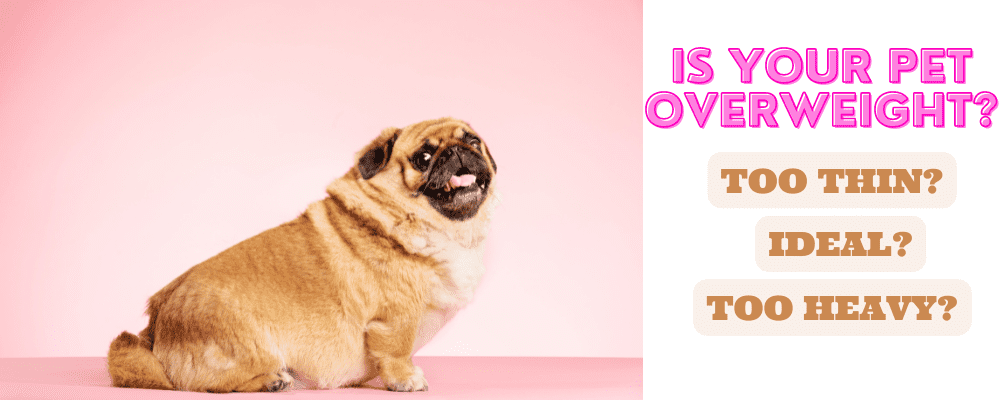Unfortunately, yes, it’s likely that your pet is overweight. According to the 2018 Association for Pet Obesity Prevention survey, more than half the cats and dogs in the United States are tipping the scales as overweight or obese, with 59% of cats and 55.8% of dogs falling into these categories. Many owners don’t realize, or even avoid finding out if their pooch is too pudgy or their feline is too flabby.
Body-condition scoring
Ever-expanding waistlines plague both the two- and four-legged members of the US population. Many people do not recognize when a pet’s weight is ideal, because they believe the perfect body condition is too thin. Veterinary practices across the country hear a wide range of excuses for a pet’s extra weight. Obesity often is a sensitive subject, but your veterinarian wants the healthiest, happiest life possible for your pet and is well-equipped to help her shed those extra pounds.
First, know where your pet falls on the body-condition scale:
Too thin
1 — Ribs, lumbar vertebrae, pelvic bones, and all bony prominences are visible from a distance; no discernible body fat; obvious loss of muscle mass
2 — Ribs, lumbar vertebrae, and pelvic bones are easily visible; no palpable fat; minimal loss of muscle mass
3 — Ribs are easily palpated and may be visible with no palpable fat; tops of the lumbar vertebrae are visible; pelvic bones are becoming prominent; obvious waist and abdominal tuck
Ideal
4 — Ribs are easily palpable, with minimal fat; waist is easily noted when viewed from above; abdominal tuck is present
5 — Ribs are palpable without excess fat; waist is observed behind the ribs when viewed from above; abdominal tuck can be seen from the side
Too heavy
6 — Ribs are palpable with slight excess fat; waist is discernible, but not prominent; abdominal tuck is present
7 — Ribs are difficult to palpate due to heavy fat cover; fat deposits are noticeable over the lumbar area and tail base; waist is absent or barely visible; abdominal tuck may be present
8 — Ribs are not palpable under heavy fat cover, or palpable only with significant pressure; heavy fat deposits are seen over the lumbar area and tail base; waist is absent; no abdominal tuck; obvious abdominal distension may be present
9 — Massive fat deposits are noticeable over the thorax, spine, and tail base; waist and abdominal tuck are absent; fat deposits are seen on neck and limbs; obvious abdominal distension is noted
You can get a rough idea of where your pet scores on the body-condition chart at home. Look at your pet from above. Does she have an hourglass figure with an indentation behind her ribs, or is she rectangular or oval in form? Next, look at your pet from the side. Does her belly tuck up as it heads toward the hind legs, or does it seem to droop and drag close to the ground? Don’t skip the rib test. Can you feel your pet’s ribs as you lightly run your hand across her side, or do you have to push hard to feel any bone under a thick layer of fat?
Obtaining your pet’s accurate body-condition score is the most helpful tool to determine her ideal weight. While it’s nice to know a specific breed should weigh a certain amount or be fed according to the guidelines on a bag of food (which usually recommend too much for most pets), each pet is an individual and requires a personalized diet and nutrition plan.
Obesity-related health problems in pets
Chubby puppies and kittens are adorable, but at what cost to their health? Overweight pets are one of the most common problems we see, and it can lead to many different disease conditions, such as:
- Diabetes
- Joint problems
- Skin infections
- High blood pressure
- Chronic inflammation
- Kidney dysfunction
- Respiratory disorders
- Metabolic and endocrine diseases
- Various cancers
Stave off potential excess weight-related diseases by battling your pet’s bulge. Aim for a slow, steady decrease in your pet’s weight. A dog can safely lose 1% to 3% of her body weight per month, while a cat can lose 0.5% to 2% per month. Make your pet work for every calorie she consumes, and burn off those extra treats. A shocking number of pets participate in little to no physical activity each day, so formulate an exercise plan in addition to a diet change. Your goal should be 30 minutes of activity per day for a dog, and three intense 5-minute play periods per day for a cat.
Calculating your pet’s caloric requirements
Weight loss is simple, right? Reduce calories and increase exercise, and the pounds should melt away. But how many calories should your pet eat per day? Should you feed what’s recommended on the food bag? Probably not. The feeding guides on dog food bags are often too high. Many only need 75-80% of that. Cut the food more if they are getting a lot of treats. Use a measuring cup or scale to measure the amount of food you are feeding.
Battle your pet’s bulge
You can show your pet how much you care in many ways other than treats. Take your dog for a sniff-friendly stroll, allowing her to smell every object along the way. Instigate a stimulating prey-and-predator game for your cat by urging her to chase a feather wand or a robotic mouse. If your pet is begging for a bite of forbidden people food, toss her some fresh veggies like carrots or green beans or a small low calorie cereal like Cheerios instead of pizza crust or a potato chip. Treats should be no more than 10% of their diet. Pets want our attention most of all, so search for rousing physical activities you can do together and prevent the obesity that threatens your pet’s health.
